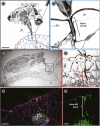Influence of cell wall polymers and their modifying enzymes during plant-aphid interactions
- PMID: 31828324
- PMCID: PMC7316967
- DOI: 10.1093/jxb/erz550
Influence of cell wall polymers and their modifying enzymes during plant-aphid interactions
Abstract
Aphids are a major issue for commercial crops. These pests drain phloem nutrients and transmit ~50% of the known insect-borne viral diseases. During aphid feeding, trophic structures called stylets advance toward the phloem intercellularly, disrupting cell wall polymers. It is thought that cell wall-modifying enzymes (CWMEs) present in aphid saliva facilitate stylet penetration through this intercellular polymer network. Additionally, different studies have demonstrated that host settling preference, feeding behavior, and colony performance of aphids are influenced by modulating the CWME expression levels in host plants. CWMEs have been described as critical defensive elements for plants, but also as a key virulence factor for plant pathogens. However, whether CWMEs are elements of the plant defense mechanisms or the aphid infestation process remains unclear. Therefore, in order to better consider the function of CWMEs and cell wall-derived damage-associated molecular patterns (DAMPs) during plant-aphid interactions, the present review integrates different hypotheses, perspectives, and experimental evidence in the field of plant-aphid interactions and discusses similarities to other well-characterized models such as the fungi-plant pathosystems from the host and the attacker perspectives.
Keywords: Aphid; callose; cell wall; cellulose; damage-associated molecular pattern (DAMP); hemicellulose; homogalacturonan; methanol; oligogalacturonides.
© The Author(s) 2019. Published by Oxford University Press on behalf of the Society for Experimental Biology.
Figures


References
-
- Abdellatef E, Will T, Koch A, Imani J, Vilcinskas A, Kogel KH. 2015. Silencing the expression of the salivary sheath protein causes transgenerational feeding suppression in the aphid Sitobion avenae. Plant Biotechnology Journal 13, 849–857. - PubMed
-
- Abe H, Funada R, Ohtani J, Fukazawa K. 1997. Changes in the arrangement of cellulose microfibrils associated with the cessation of cell expansion in tracheids. Trees 11, 328–332.
-
- Adams JB, Drew ME. 1965. A cellulose-hydrolyzing factor in aphid saliva. Canadian Journal of Zoology 43, 489–496. - PubMed
-
- Agüero CB, Uratsu SL, Greve C, Powell AL, Labavitch JM, Meredith CP, Dandekar AM. 2005. Evaluation of tolerance to Pierce’s disease and Botrytis in transgenic plants of Vitis vinifera L. expressing the pear PGIP gene. Molecular Plant Pathology 6, 43–51. - PubMed
Publication types
MeSH terms
Substances
LinkOut - more resources
Full Text Sources

